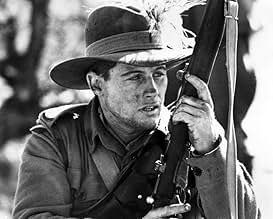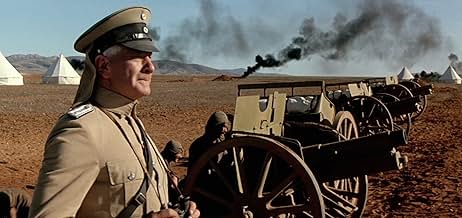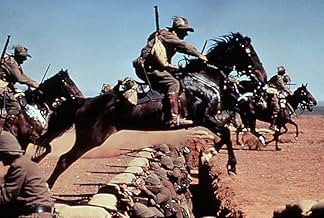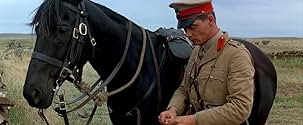IMDb रेटिंग
6.8/10
2.2 हज़ार
आपकी रेटिंग
अपनी भाषा में प्लॉट जोड़ेंIn 1917 when the British forces are bogged down in front of the Turkish and German lines in Palestine they rely on the Australian light horse regiment to break the deadlock.In 1917 when the British forces are bogged down in front of the Turkish and German lines in Palestine they rely on the Australian light horse regiment to break the deadlock.In 1917 when the British forces are bogged down in front of the Turkish and German lines in Palestine they rely on the Australian light horse regiment to break the deadlock.
- पुरस्कार
- 2 जीत और कुल 1 नामांकन
Jack Heywood
- Dave's Dad
- (as John Heywood)
फ़ीचर्ड समीक्षाएं
This colossal 1987 production - believe it or not - from RKO PICTURES is an Australian film closely resembling LAWRENCE OF ARABIA in its intent and rightly compared to ZULU. With a huge cast of Oz actors and directed by PHAR LAP (look it up) warhorse Simon Wincer it is basically about the last massive charge in the Middle East desert during World War One....an event still on the yearly Australian military forces roster of "Anzac" celebrations. Many other comments on this site will give you details of the history of the event and rightly applaud this lavish spectacular film. RKO Pictures had reformed with some co financing in the 80s and this is one of their few productions. BEST LITTLE WHOREHOUSE and THE BORDER are two others that spring to mind produced with Universal Pictures. With a $7 million budget and all of it on screen THE LIGHTHORSE became the last of the truly international films from Australia in the 80s. Others of this time are GALLIPOLI and CAREFUL HE MIGHT HEAR YOU and THE MAN FROM SNOWY RIVER and WE OF THE NEVER NEVER...each are films made with a lavish widescreen cinema release in mind and each huge Oz successes. THE LIGHTHORSEMEN is well worth the 140 minutes or so of carefully paced storytelling, all laced with Aussie humor and superb design and photography. The charge in the last two reels is truly breathtaking and on a cinema screen was particularly overwhelming, rivaling the battle charge in LAWRENCE OF ARABIA for sheer thrilling visuals. No CGI in this film... it is all real and scary and played and filmed for keeps. One thrill for cinema owners of the day was to have the film commence with the original cinema scope RKO logo...beeping away from the tower on top of the world. Wonderful!
This is a story about some episode British-Turk campaign in Palestine in 1917. Very important role in this campaign was played by Australian forces. The key to conquer the Holy Land is city of Gaza. British general wants however to throw his forces to bypass the city and capture another one - Beersheba. To take them both it is necessary to keep his plan secret.
As a person who is interested in all WWI history I was waiting for this movie. I find it very good. All equipment seems to be very accurate, however, I've never heard about use of tanks in this front. There is a nice scene of air attack by German biplane, cars from that times, uniforms, and so on -- it all seems to be historical correct. The final charge is worth waiting for. I think that anyone who is interested in this campaign would be satisfied.
Because of Australian point of view the role of British army seems to be a little underrated. I especially mean British commander -- general Allenby. I think it would be good to say at the very end that after capturing Beersheba, Gaza fell as well a week later, and the road to Jerusalem was opened. This was what was lacking for me.
As a person who is interested in all WWI history I was waiting for this movie. I find it very good. All equipment seems to be very accurate, however, I've never heard about use of tanks in this front. There is a nice scene of air attack by German biplane, cars from that times, uniforms, and so on -- it all seems to be historical correct. The final charge is worth waiting for. I think that anyone who is interested in this campaign would be satisfied.
Because of Australian point of view the role of British army seems to be a little underrated. I especially mean British commander -- general Allenby. I think it would be good to say at the very end that after capturing Beersheba, Gaza fell as well a week later, and the road to Jerusalem was opened. This was what was lacking for me.
This impressive flick is based on a true story and most of the characters in the film were based on real people and dealing with the continued coming of age of the Australian nation and its soldiers . The film follows Four Australians, Frank (Gary Sweet), Scotty (Jon Blake who was injured in a car accident and he suffered permanent paralysis and brain damage until his recent death) an Irish-Australian, Chiller (Tim McKenzie) and Tas (John Walton) in Palestine in 1917, part of the 4th Light Horse Brigade of the British and Commonwealth Dominion forces. When Frank is wounded and dies of his wounds, he is replaced by Dave (Peter Phelps). Dave finds himself unable to fire his weapon in combat and is transferred to the Medical Corps, where he will not need to carry a weapon, but where he will still be exposed to the fighting . After the Second Battle of Gaza ended in complete failure, General Archibald Murray (Tony Bonner) , the commander in chief of the British forces in Egypt and Palestine, was replaced by the distinguished cavalry commander, General Edmund Allenby (Anthony Hawkins) , formerly the commander of the British Third Army on the Western Front to carry out the British plan the capture of Beersheba. During an attack by Turkish cavalry, Major Richard Meinertzhagen (Anthony Andrews) deliberately leaves behind documents indicating that the attack on Beersheba will only be a diversion. At the ending there takes place the Battle of Beersheba (Turkish: Birüssebi Savaşı) that was one critical element of a wider British offensive, known as the Third Battle of Gaza, aimed at breaking the Ottoman defensive line that stretched from Gaza on the Mediterranean shore to Beersheba ; it took place on 31 October 1917, as part of the Sinai and Palestine campaign during World War I . Notable was the charge of the Australian 4th Light Horse Brigade, which covered some 6 kilometres (3.7 mi) to overrun and capture the last remaining Ottoman trenches, and secure the surviving wells at Birüssebi . The total losses incurred by the Desert Mounted Corps was 53 men killed and 144 wounded. The heaviest Allied losses were suffered by the British infantry of XX Corps, which lost 116 killed in action, although the total number of men killed during the battle from the British force was far greater, totalling 171 men.
It follows in the wake of other Australian New Wave war movies such as Breaker Morant (1980), Gallipoli (1981), and the 5-part TV series Anzacs (1985). Recurring issues of these films include the Australian identity , such as mateship and friendship , ANZAC spirit , the loss of innocence in war, and breathtaking battles spectacularly filmed . Acceptable acting from main and support cast including prestigious Aussie/English actors such as Anthony Andrews , Shane Bryant , Sigrid Thornton , Tony Bonner , Gary Tweed , Bill Kerr , though none of the performances are really bad, but none are very good . Gorgeous outdoors are well photographed by cameraman Dan Cundey . Despite being set in Palestine and Egypt, the film was shot entirely on location in Victoria and Hawker, South Australia . Rousing and emotive musical score was composed by Mario Millo. It was nominated for Best Achievement in Cinematography and won an Australian Film Institute award in 1988 for Best Original Music Score and another for Best Achievement in Sound. It grossed a lot of money at the box office in Australia . Sensational directorial by the notorious filmmaker Simon Wincer, a Western expert, as he emigrated Hollywood and subsequently directed to Tom Selleck in ¨Monte Walsh¨ , ¨Crossfire trail¨ and ¨Quigley Down Under¨ to Paul Hogan in ¨Relampago Jack¨ and ¨Cocodrile Dundee in L.A.¨ and usually directs episodes for TV mini-series, such as ¨Into the West¨, ¨The Ponderosa¨ , ¨Lonesome Dove¨ and ¨The adventures of young Indiana Jones¨ , among others . Rating: good for the sensitive direction and proficient film-making ; the result is a sort of pacifist-aggressive war adventure . Worthwhile watching .
It follows in the wake of other Australian New Wave war movies such as Breaker Morant (1980), Gallipoli (1981), and the 5-part TV series Anzacs (1985). Recurring issues of these films include the Australian identity , such as mateship and friendship , ANZAC spirit , the loss of innocence in war, and breathtaking battles spectacularly filmed . Acceptable acting from main and support cast including prestigious Aussie/English actors such as Anthony Andrews , Shane Bryant , Sigrid Thornton , Tony Bonner , Gary Tweed , Bill Kerr , though none of the performances are really bad, but none are very good . Gorgeous outdoors are well photographed by cameraman Dan Cundey . Despite being set in Palestine and Egypt, the film was shot entirely on location in Victoria and Hawker, South Australia . Rousing and emotive musical score was composed by Mario Millo. It was nominated for Best Achievement in Cinematography and won an Australian Film Institute award in 1988 for Best Original Music Score and another for Best Achievement in Sound. It grossed a lot of money at the box office in Australia . Sensational directorial by the notorious filmmaker Simon Wincer, a Western expert, as he emigrated Hollywood and subsequently directed to Tom Selleck in ¨Monte Walsh¨ , ¨Crossfire trail¨ and ¨Quigley Down Under¨ to Paul Hogan in ¨Relampago Jack¨ and ¨Cocodrile Dundee in L.A.¨ and usually directs episodes for TV mini-series, such as ¨Into the West¨, ¨The Ponderosa¨ , ¨Lonesome Dove¨ and ¨The adventures of young Indiana Jones¨ , among others . Rating: good for the sensitive direction and proficient film-making ; the result is a sort of pacifist-aggressive war adventure . Worthwhile watching .
Despite the ubiquitous appearance by Sigrid Thorton, and my having to eat crow over my previous comments on Anthony Andrew's acting ability (no scenery chewing or hamming it up here), I very much enjoyed this outstanding Aussie film.
Simon Wincer has directed a wide variety of films, some bad (like the Cheryl Ladd waste of celluloid "Bluegrass" and the turkey "Pharlap") and some very good (like the intense "Harlequin" and the great A&E mini "PT Barnum"). I find this one to be particularly special due to it containing one of the best war sequences on film.
Wincer and his crew have excellently interwoven a beautifully done drama with incredible special effects. The battle sequence at the end if the film is so powerful that even seen on video on an average size home TV it is astounding. Not only is the Lighthorsemen's assault wonderfully choreographed, but the reaction shots of the cast are well performed. You can see the private struggles going on in the face of the big one.
This is not a movie for the faint of heart nor should it be dismissed as just another war movie by those a little leery of the genre.
Simon Wincer has directed a wide variety of films, some bad (like the Cheryl Ladd waste of celluloid "Bluegrass" and the turkey "Pharlap") and some very good (like the intense "Harlequin" and the great A&E mini "PT Barnum"). I find this one to be particularly special due to it containing one of the best war sequences on film.
Wincer and his crew have excellently interwoven a beautifully done drama with incredible special effects. The battle sequence at the end if the film is so powerful that even seen on video on an average size home TV it is astounding. Not only is the Lighthorsemen's assault wonderfully choreographed, but the reaction shots of the cast are well performed. You can see the private struggles going on in the face of the big one.
This is not a movie for the faint of heart nor should it be dismissed as just another war movie by those a little leery of the genre.
I have watched this movie at least five times. Initially, I was a little disappointed by the tedium of the first half of the movie. I began to realize, however, that the first half of the movie is a pretty good reflection of military life prior to the second half of the 20th century: long periods of boredom and routine punctuated by major confrontations.
I've noticed that a few reviewers have remarked on the final "cavalry charge," which suggests to me that they really weren't paying much attention to the movie. The final charge on the Turkish positions is so much more awe-inspiring given the usual tactics of the Lighthorsemen. One of the most thrilling moments is when the Aussies prepare to meet the enemy on horseback and, instead of pulling out the classic cavalrymen's sabers, draw their bayonets for the charge. You almost want to laugh at the sight of 16" knives against the well-emplaced Turks.
This is one of the few war movies based on actual events that is fairly accurate, too. Take a look at some of the sites dedicated to the 4th Light Horse Briagde and you will see what I mean. A letter from one of the actual participants to his brother is an almost perfect description of the events as shown in the movie.
**** out of ***** if only for the charge
I've noticed that a few reviewers have remarked on the final "cavalry charge," which suggests to me that they really weren't paying much attention to the movie. The final charge on the Turkish positions is so much more awe-inspiring given the usual tactics of the Lighthorsemen. One of the most thrilling moments is when the Aussies prepare to meet the enemy on horseback and, instead of pulling out the classic cavalrymen's sabers, draw their bayonets for the charge. You almost want to laugh at the sight of 16" knives against the well-emplaced Turks.
This is one of the few war movies based on actual events that is fairly accurate, too. Take a look at some of the sites dedicated to the 4th Light Horse Briagde and you will see what I mean. A letter from one of the actual participants to his brother is an almost perfect description of the events as shown in the movie.
**** out of ***** if only for the charge
क्या आपको पता है
- ट्रिवियाWebsite Cinephilia reports of the Jon Blake accident and legal case: "Jon Blake was critically injured whilst driving home on December 1, 1986, after the final day's filming of The Lighthorsemen (1987). He sustained severe brain injuries and in December, 1995, the New South Wales Supreme Court ruled that Blake should be compensated for the loss of potential earnings as a star in the United States. After taking evidence from actors, directors, and film critics who indicated his career could have been as big as Mel Gibson's, the court awarded him $32 million in damages. This was later reduced to $7 million after the defence appealed."
- गूफ़At the rest camp just after the 2 soldiers pass the British Major and addresses the Colonel about the men wearing shorts at the end the Colonel calls the Major 'Sir', this wouldn't happen as a Colonel is a higher rank to Major.
- इसके अलावा अन्य वर्जनUK versions are cut by 6 secs to remove cruel horsefalls.
- कनेक्शनEdited into The Young Indiana Jones Chronicles: Palestine, October 1917 (1993)
- साउंडट्रैकAUSTRALIA WILL BE THERE
Music and lyrics by W.W. 'Skipper' Francis
By Arrangement with Allans Music (Australia) Pty. Limited
टॉप पसंद
रेटिंग देने के लिए साइन-इन करें और वैयक्तिकृत सुझावों के लिए वॉचलिस्ट करें
- How long is The Lighthorsemen?Alexa द्वारा संचालित
विवरण
- रिलीज़ की तारीख़
- कंट्री ऑफ़ ओरिजिन
- आधिकारिक साइटें
- भाषा
- इस रूप में भी जाना जाता है
- The Light Horse Men
- फ़िल्माने की जगहें
- St. Kilda, मेलबोर्न, विक्टोरिया, ऑस्ट्रेलिया(beach, Mediterranean Sea)
- उत्पादन कंपनियां
- IMDbPro पर और कंपनी क्रेडिट देखें
बॉक्स ऑफ़िस
- बजट
- A$1,05,00,000(अनुमानित)
- US और कनाडा में सकल
- $33,779
- US और कनाडा में पहले सप्ताह में कुल कमाई
- $23,645
- 10 अप्रैल 1988
- दुनिया भर में सकल
- $34,514
- चलने की अवधि
- 2 घं 11 मि(131 min)
- ध्वनि मिश्रण
- पक्ष अनुपात
- 2.35 : 1
इस पेज में योगदान दें
किसी बदलाव का सुझाव दें या अनुपलब्ध कॉन्टेंट जोड़ें




























